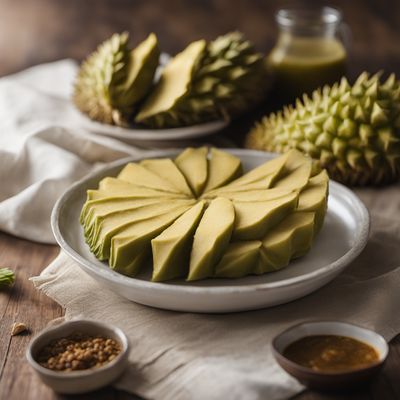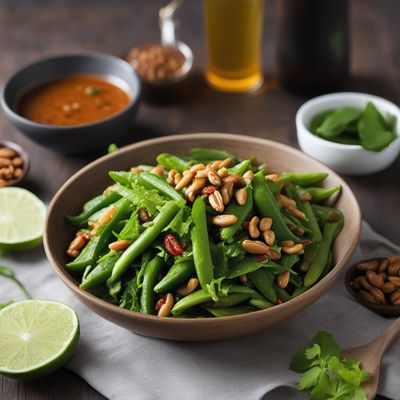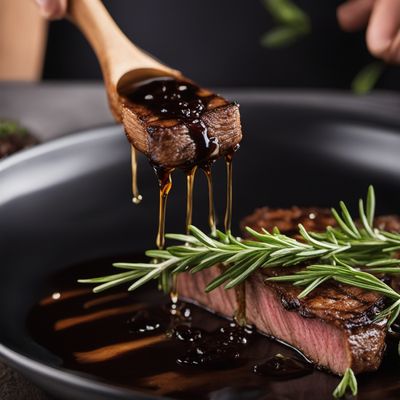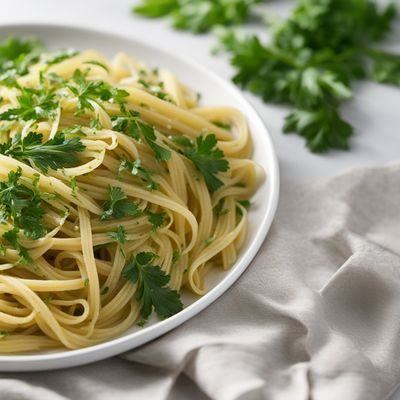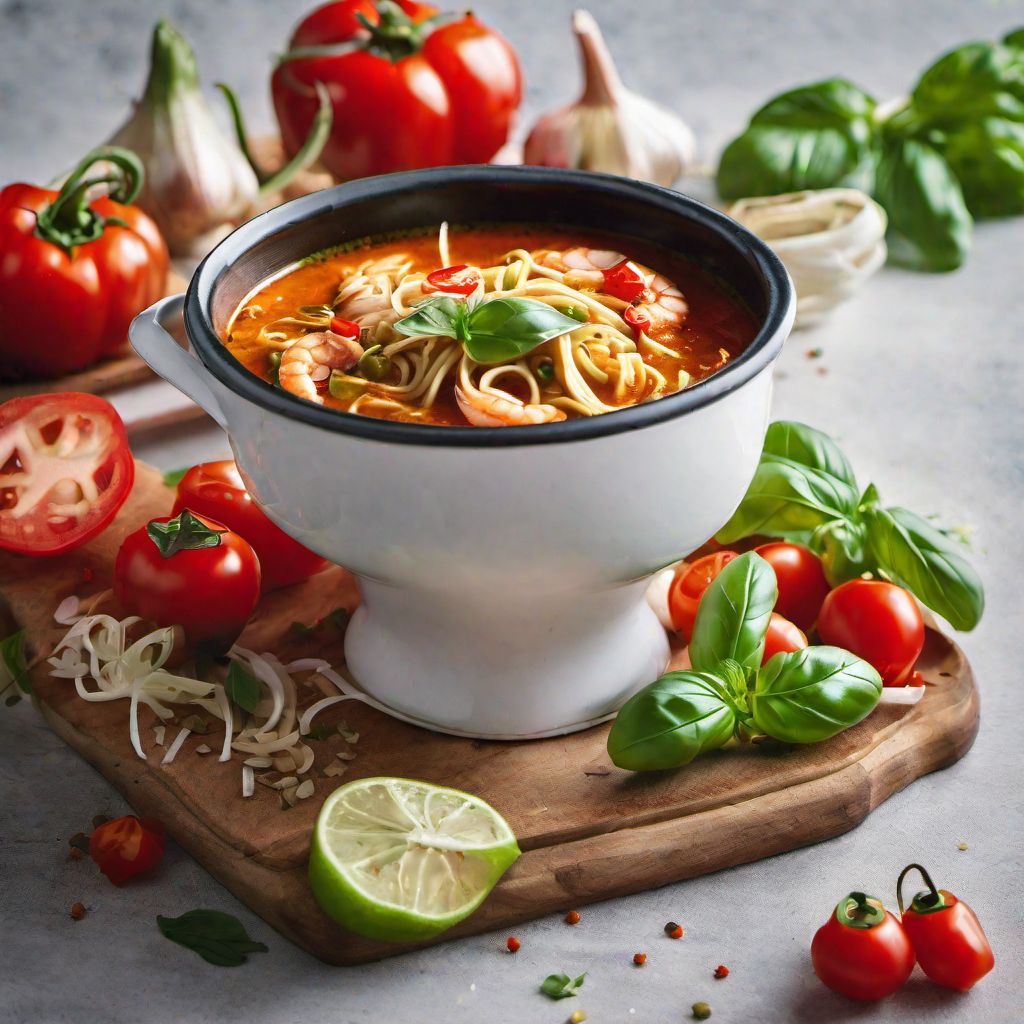
Recipe
Italian-Style Laksa
Zesty Tomato and Seafood Laksa with Italian Flair
4.8 out of 5
In the realm of Italian cuisine, this Italian-Style Laksa brings a delightful twist to the traditional Malaysian dish. Bursting with vibrant flavors, this zesty tomato and seafood laksa is a fusion of Italian and Malaysian culinary traditions. The rich tomato base, infused with aromatic herbs and spices, perfectly complements the succulent seafood, creating a tantalizing dish that will transport your taste buds to the sunny shores of Italy.
Metadata
Preparation time
20 minutes
Cooking time
25 minutes
Total time
45 minutes
Yields
4 servings
Preparation difficulty
Medium
Suitable for
Pescatarian, Dairy-free, Gluten-free (if using gluten-free pasta), Low-fat, Low-calorie
Allergens
Shellfish, Gluten (if using regular pasta)
Not suitable for
Vegan, Vegetarian, Paleo, Keto, Nut-free
Ingredients
While the original Malaysian laksa typically features a coconut milk-based broth, this Italian adaptation replaces it with a tomato-based broth. The Italian-Style Laksa also incorporates Italian herbs and spices, such as basil and oregano, to infuse the dish with Mediterranean flavors. Additionally, the seafood selection in this recipe leans towards Italian favorites like shrimp, mussels, and calamari. We alse have the original recipe for Laksa, so you can check it out.
-
2 tablespoons (30ml) olive oil 2 tablespoons (30ml) olive oil
-
1 onion, finely chopped 1 onion, finely chopped
-
3 garlic cloves, minced 3 garlic cloves, minced
-
1 red chili, deseeded and finely chopped 1 red chili, deseeded and finely chopped
-
1 tablespoon (15g) tomato paste 1 tablespoon (15g) tomato paste
-
1 can (400g) diced tomatoes 1 can (400g) diced tomatoes
-
2 cups (470ml) fish or vegetable broth 2 cups (470ml) fish or vegetable broth
-
1 teaspoon dried basil 1 teaspoon dried basil
-
1 teaspoon dried oregano 1 teaspoon dried oregano
-
1 teaspoon paprika 1 teaspoon paprika
-
1 teaspoon sugar 1 teaspoon sugar
-
Salt and pepper, to taste Salt and pepper, to taste
-
200g spaghetti or linguine 200g spaghetti or linguine
-
200g shrimp, peeled and deveined 200g shrimp, peeled and deveined
-
200g mussels, cleaned and debearded 200g mussels, cleaned and debearded
-
200g calamari rings 200g calamari rings
-
Fresh basil leaves, for garnish Fresh basil leaves, for garnish
-
Freshly grated Parmesan cheese, for serving Freshly grated Parmesan cheese, for serving
Nutrition
- Calories (kcal / KJ): 380 kcal / 1590 KJ
- Fat (total, saturated): 8g, 1g
- Carbohydrates (total, sugars): 48g, 8g
- Protein: 28g
- Fiber: 4g
- Salt: 1.5g
Preparation
-
1.In a large pot, heat the olive oil over medium heat. Add the chopped onion, minced garlic, and red chili. Sauté until the onion becomes translucent.
-
2.Stir in the tomato paste and cook for an additional minute.
-
3.Add the diced tomatoes, fish or vegetable broth, dried basil, dried oregano, paprika, sugar, salt, and pepper. Bring the mixture to a simmer and let it cook for 15 minutes, allowing the flavors to meld together.
-
4.Meanwhile, cook the spaghetti or linguine according to the package instructions until al dente. Drain and set aside.
-
5.Add the shrimp, mussels, and calamari rings to the simmering broth. Cook for 5-7 minutes, or until the seafood is cooked through and the mussels have opened.
-
6.Divide the cooked spaghetti or linguine among serving bowls. Ladle the seafood and tomato broth over the pasta.
-
7.Garnish with fresh basil leaves and serve with freshly grated Parmesan cheese on the side.
Treat your ingredients with care...
- Shrimp — Ensure the shrimp is peeled and deveined before adding it to the laksa. If using frozen shrimp, thaw them thoroughly and pat them dry with a paper towel to remove excess moisture.
- Mussels — Clean the mussels by scrubbing them under cold water and removing any beards. Discard any mussels that are cracked or do not close when tapped.
- Calamari rings — If using fresh calamari, slice it into rings. If using frozen calamari rings, thaw them according to the package instructions before adding them to the laksa.
Tips & Tricks
- For a spicier kick, add a pinch of chili flakes or a dash of hot sauce to the laksa.
- Customize the seafood selection based on your preferences. You can add scallops, clams, or any other seafood you enjoy.
- If you prefer a creamier laksa, you can add a splash of heavy cream or coconut milk to the broth.
- Freshly grated Parmesan cheese adds a delightful touch of umami to the dish, but you can omit it if you prefer a dairy-free option.
- Serve the Italian-Style Laksa with a side of crusty Italian bread for dipping into the flavorful broth.
Serving advice
Serve the Italian-Style Laksa hot, garnished with fresh basil leaves. Accompany it with a side of freshly grated Parmesan cheese for sprinkling over the laksa, allowing each diner to customize their dish according to their taste preferences.
Presentation advice
Present the Italian-Style Laksa in individual serving bowls, with the spaghetti or linguine neatly arranged at the bottom. Ladle the seafood and tomato broth over the pasta, ensuring an even distribution of shrimp, mussels, and calamari. Garnish with fresh basil leaves for a pop of color.
More recipes...
For Laksa » Browse all
For Malaysian cuisine » Browse all
More Malaysian cuisine dishes » Browse all

Kuih cara berlauk
Kuih cara berlauk is a traditional Malaysian snack that is made with a savory filling and a sweet pastry shell. It is a delicious and flavorful...

Roti bawang
Roti bawang is a Malaysian flatbread that is flavored with onions and spices. It is a popular snack and is often served with a spicy dipping sauce.

Lor mee
Braised Noodles
Lor mee is a popular noodle dish in Singapore and Malaysia, made with thick yellow noodles in a thick and savory gravy.
More Italian cuisine dishes » Browse all

Gianduiotto
Gianduiotto is a traditional Italian chocolate made with hazelnuts. It is a popular treat throughout Italy and is often given as a gift during the...

Nevole
Nevole is a traditional Italian cake that is made with chestnut flour. It has a dense, moist texture and a nutty flavor that is perfect for fall.

Berlingozzo
Berlingozzo is a traditional Italian cake that is made with almonds, lemon zest, and sugar. It is a simple and delicious cake that is perfect for...





